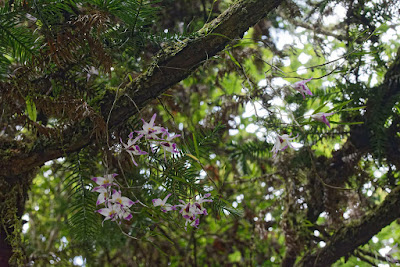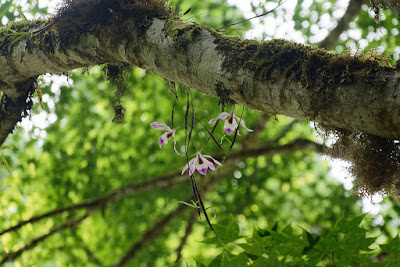Dendrobium falconeri is widespread in India and south-east Asia. Natural habitats include the areas of Bhutan, Assam, Khasi (Khasia) Hills in north-east India, Burma, northern Thailand and China, as well as the easternmost of Taiwan.
Dendrobium falconeri, also called as Falconer's Dendrobium ( named after the English Director of Calcutta Botanical Gardens), Callista falconeri, Dendrobium erythroglossum, Dendrobium falconeri albidulum, Dendrobium falconeri var. albidulum, Dendrobium falconeri var. giganteum, Dendrobium falconeri var. robustum, Dendrobium falconeri var. senapatianum, is a species of the genus Dendrobium. This species was described by William Jackson Hooker in 1856.
IDENTIFY DENDROBIUM FALCONERI
Dendrobium falconeri is widespread in India and south-east Asia. Natural habitats include the areas of Bhutan, Assam, Khasi (Khasia) Hills in north-east India, Burma, northern Thailand and China, as well as the easternmost of Taiwan. These plants usually grow on slightly shaded branches of broad-leaved trees, at heights of 1000-1800 m.
It is a large sized, cool to warm growing epiphyte, which can reach a height of 60-120 cm, with pendant, branching, knotty, soft, slender, 60-120 cm long stems that frequently form roots at the nodes and grow into a tangled mess. The few, linear, grass-like, quickly deciduous, 2.5-7.7 cm long leaves arise on new growth at the apex.
Falconer's Dendrobium blooms on a very short, single flowered inflorescence that arises all along the old and new canes with a single, fragrant flower that lasts about 2 weeks occurring in the spring. The flowers are 5-10 cm in diameter. The pointed petals of both whorls are white to pinkish-white with amethyst-purple tops. The white lip has an amethyst top and a dark purple thickening at the base of the throat. The mark is surrounded by a yellow spot extending to the side plots.
DENDROBIUM FALCONERI CARE AND CULTURE
Cultural information should only be used as a guide, and should be to be adapted to suit you. Your physical location; where you grow your plants, how much time you have to devote to their care, and many other factors, will need to be taken into account. Only then can you decide on the cultural methods that best suit you and your plants.
Light:
Dendrobium falconeri needs a light level of 25000-35000 lux, some shading is required from spring to autumn, but the light level should be as high as possible, which the plant can tolerate without scalding the leaves.
Temperature:
The average temperature of the summer day is 23-25 ° C, the night 16-17 ° C, giving a daily difference of 7-9 ° C. In spring, the average temperature of the day is 27-28 ° C, night 10-16 ° C, giving a daily difference of 11-18 ° C. In winter, the average day temperature is 22-25 ° C, the night 6-7 ° C, giving a daily difference of 15-18 ° C.
Humidity:
This species needs a humidity level of 75-85% for most of the year. At the end of summer, the average humidity increases to 85%, and at the end of winter and at the beginning of spring it drops to almost 60%.
Substrate, growing media and repotting:
Dendrobium falconeri can be grown mounted on tree ferns or cork, which favors their overhanging habitat. It is necessary to ensure high humidity and summer watering at least once a day. If it is not possible to grow plants on rootstocks, they can be grown in small pots or hanging baskets filled with any loose, quickly drying substrate. Repotting can be carried out at any time as new roots are actively growing.
Watering:
From the end of spring to the beginning of autumn, water is moderate to heavy, but it is very dry in winter. The plants should be moist during active growth, but when new growths reach maturity in autumn, the amount of water should be reduced.
Fertilizer:
Weekly 1/4-1/2 doses are recommended. From spring to mid-summer, high-nitrogen fertilizer is recommended, and then until the end of autumn high-phosphoric fertilizer.
Rest period:
Cold, dry rest is very important for Dendrobium falconeri and should last until new growths appear in the spring. You can eliminate water in winter, but the plants are in better condition if during the winter they allow them to dry out between watering, but they do not stay dry for too long. Within 1-2 months at the end of winter, the plant should dry completely between waterings and remain dry for a slightly longer period. Occasional morning fogging between waterings should prevent too much drying. Fertilization should be significantly reduced or eliminated until spring, when normal watering begins.















COMMENTS